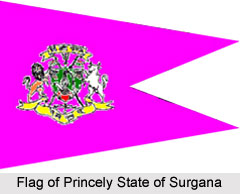 The Princely State of Surgana was one of the well known princely states of India which were managed and administered by native rulers or Indian princes under the indirect control of the British Government of India. Surgana state included 60 villages and was bordered by the Dangs and British India in the north, by Dharampur, Bansda and British India in the west, by Syadhri hills of Nasik and Khandeshm in the east and by by Peint in Nashik in the south. The princely state was a part of the Baroda Agency and was later included in the West Indian States and the Indian state of Gujarat.
The Princely State of Surgana was one of the well known princely states of India which were managed and administered by native rulers or Indian princes under the indirect control of the British Government of India. Surgana state included 60 villages and was bordered by the Dangs and British India in the north, by Dharampur, Bansda and British India in the west, by Syadhri hills of Nasik and Khandeshm in the east and by by Peint in Nashik in the south. The princely state was a part of the Baroda Agency and was later included in the West Indian States and the Indian state of Gujarat.
The native ruler of the state held the title of Deshmukh. The Powar Marathas claimed to be the ruling family of Surgana princely state. The Konkani Kanbis were the ancestors of the Deshmukh, who resided in the mountains regions near Hatgad. The clan was not interrupted by the Mughal forces as the only needed to prevent the Kolis and the Bhils of the Dangs from traveling further than the Western Ghats. The Deshmukhs declined to pay any revenue to the Maratha Empire, who nonetheless tried to pacify the chief as the region of Surgana was strategically located. In the year 1819, the princely state of Surgana came under the security and protection of the British East India Company.
The Princely State of Surgana was ranked in the 14th place among the states of Gujarat, immediately after Jambhughoda. The state paid no annual tribute to the British administration or any other Indian state. Surgana exercised full civil and criminal jurisdiction, with the restrictions to capital offences. The chiefship descended in the line of one branch, whereas the representative of other branch, particularly Bhadarkar, was entitled to a monthly allowance and a share of the state balance at the year end.
The princely state of Surgana was one of the original constituent members of the Chamber of Princes, a number of smaller states indirectly represented by 12 princes whom they elected periodically. Due to the continuous requirement for Government supervision, the state was exempted from the 1943 Attachment Scheme.
After the Indian independence in the year, 1947, the princely state was acceded to the Union of India. At present, Surgana is a taluka and a town in the district of Nashik, in Maharashtra state, India.



















